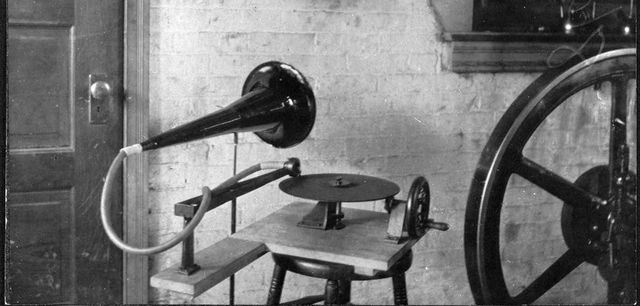15 February 2024
By its very nature, music is fleeting. It arises in the moment only to disappear into the past and is kept alive only in the memory of the listener. It is for this reason that people have grappled for centuries with the problem of how to record sound so that it can be played back. A dream that only became reality in the 19th century.
It’s 6 December 1877, the scene is Menlo Park, close to New York City. In his factory, Thomas Alva Edison is bent over a funnel. He is turning a little handle, which for its part rotates a cylinder. Then, the 30-year-old inventor says: “Hello, hello.” He follows this by singing the nursery rhyme “Mary had a little lamb”. Edison then goes back to turning the handle, and the cylinder begins to rotate once more. And, emerging from the funnel, he hears the quiet words: “Mary had a little ...” So it is that Thomas Alva Edison becomes the first person ever to hear a recording of their own voice.
The phonograph, the name Edison gives his invention for the recording and playback of sounds, is a by-product of his work on the automatic telegraph. And it works like this: When someone speaks into the funnel, the sound activates a membrane, which starts to vibrate. Sitting on the membrane is a steel needle which inscribes these vibrations onto a piece of tinfoil.
Edison starts selling his phonograph in 1878.But the initial wave of public enthusiasm swiftly ebbs. This is because the cylinder is virtually incapable of recording more than thirty seconds’ worth of sounds, cannot be duplicated and is destroyed after just a few replays. To cap it all, the sound recordings are very quiet and of only moderate quality.
From the phonograph to the graphophone
Disappointed, Edison turns his attention to other inventions. So, it falls to others to improve the technology: engineer Charles Sumner Tainter and chemist Chichester Bell, the cousin of Alexander Graham Bell, the inventor of the world’s first functional telephone. Bell and Tainter replace the tin foil with a layer of wax and the steel needle with a sapphire. The result is better, longer and more durable recordings with a significant reduction in background noise. Bell and Tainter launch their “graphophone” commercially in 1888. Edison, too, turns his attention to wax in the same year and starts working on further improvements to his “speaking machine”.
© Adobe Stock
He sees its greatest potential in being an office dictation machine. However, it’s at carnivals that these sound-recording cylinders really take off – as music playback devices. As the cylinders still have a short service life, the actors involved want to play them to as many people as possible at the same time. The audience listens to the musical offerings via hearing tubes – and here we have the birth of the headphone party, or silent disco. And yet, these sound-recording cylinders are not a great commercial success. This is due to the appearance on the market of a genuine competitor in the form of a black disc.
Emil Berliner and the phonograph record
In 1887, German migrant to the US Emil Berliner files a patent application for a “method and device for the recording and playing back of sounds”. Like Edison, whose phonograph Berliner has studied closely, for recording purposes he uses a sound funnel, a membrane and a needle which inscribes the sounds onto tinfoil. However, unlike his famous fellow inventor, Berliner, a native of Hanover, changes the angle between the needle and the foil by 90 degrees. This makes the recording more accurate and permits the use of a flat recording medium the phonograph record. The playback device, which follows the grooves on the record and renders the recorded sounds audible once more, Berliner names the “gramophone”.
The first gramophone records are made of zinc, but Berliner switches to hard rubber in 1890. However, the background noise on the records is still so loud that they are effectively useless for recording music. So, Berliner, who has in the meantime set up two gramophone and record companies in the US, experiments with other materials: The year 1897 sees the release of the first shellac gramophone record. It consists of a mix of powdered rock, carbon black, plant fibres and, as the name suggests, shellac, a resinous secretion of the female lac insect. This mix is easy to mould and press, hardens well, and becomes the gold standard of gramophone record production for the next 60 years.
© Everett Collection via picture alliance
From luxury product to mass medium
The first major star of the new gramophone age is a young Italian tenor: On 11 April 1902, Enrico Caruso sings ten tracks, which are recorded by Berliner’s sound engineer, Fred Gaisberg. Caruso’s recordings are a smash hit, prompting other famous artists alongside the customers to warm to the new medium. By 1904, Emil Berliner’s Deutsche Grammophon company in Hanover is producing 28,000 shellac discs per day, a figure which shoots up to 36,000 just two years later.
The gramophone soon becomes a fixture of middle class living rooms. For white-collar staff and workers, however, it is in many cases unafforable. In 1904, a gramophone records costs two marks fifty, the average monthly salary being 50 marks. In 1922, the wax investment casting method used to date is replaced by the matrix system. The benefit of the “father-mother-son” method is this: Whereas each copying process involves the destruction of the wax moulds, the matrices can be used indefinitely for reproduction purposes. It will from then onwards be much cheaper and quicker to press the records.
© picture alliance
And the sound quality will also soon improve vastly. The Bell Telephone Company develops the electro-acoustic recording method in 1924. The sound waves are captured by an electric microphone and converted into electrical impulses. This makes it possible to record quiet sounds and instruments which the sound funnels have never been sensitive enough to pick up. With the invention of the electric amplifier, these gramophone recordings can now also be played back via a loudspeaker. The sound is not only significantly louder but also much clearer than that offered by the existing gramophone funnel, and a new era begins for the recording and playback of sound.
The long road to the long-playing record
However, one side of a record can accommodate no more than four to six minutes’ worth of sound. Various companies begin experimenting with other materials, smaller grooves and lower rotation speeds. But none of these systems can make a decisive breakthrough. Until 21 June 1948, that is, when Columbia Records unveils the world’s first vinyl long-playing record. This turns at a speed of 33 1/3 rotations per minute and soon becomes the standard for gramophone records.
But there’s still a problem: Once a sound is recorded, it stays recorded. Every time someone makes a mistake, the whole orchestra has to start again. For shorter pieces of music, this is manageable, albeit tedious, but it’s a real issue for longer recordings. But help is forthcoming from Europe – in the form of magnetic tape.






